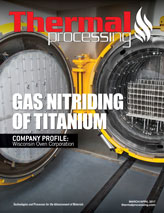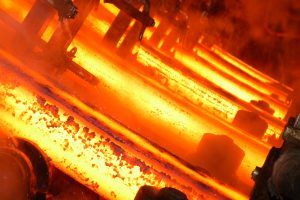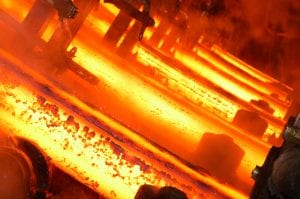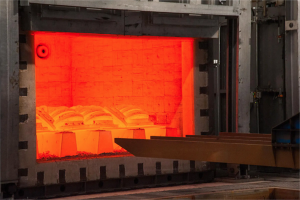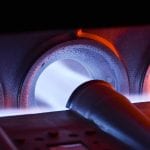The process of finding leaks in your vacuum heat-treating system can sometimes be a lengthy process. However, a deeper understanding of best practices for finding and correcting leaks can go a long way in simplifying the process.
While one of the more common ways to perform a leak check is with a helium mass spectrometer, there is also the rate of rise test, commonly known as the CDE (clean, dry, empty) linear leak rate. This comes later, when you want to know the rate of rise, or the true linear leak rate, of your vacuum furnace. To determine the true linear leak rate, you should:
- Pump the furnace down.
- Let it sit for a predetermined amount of time (depending on the temperature of the furnace and the processes you are running).
- Stop the process cycle, which separates the vacuum pumping system from the furnace.
- Watch the rate of rise over a one-hour time period.
However, this is an area where some people often fail their mandated leak rate. This is because you do not necessarily obtain a true linear leak rate in a one-hour time sample since no one can truly ascertain linearity from one sample. Rather, you need to take multiple samples.
For example, you require a leak rate of 5 microns per hour or less. If you pump the vacuum furnace down to 1 micron, shut it off, and come back in an hour to find it has gone up to 8 microns, then the leak rate is 7 microns/hour. If you look at just this sample, you would fail your mandated leak rate.

Looking at the same situation again, you come back in one hour to find the leak rate is 7 microns/hour. Instead of stopping at that point, though, you let it sit for another hour because, if it is truly linear, it will double (go up by 7 microns) in another hour. Then you could say it is linear and it fails. However, if in that second hour, it instead goes from 8 to 10 microns, then you would divide 10 by two hours, and you would get a leak rate of 5 microns/hour, thus meeting your required leak rate.
So many people give up prematurely during this process, and they have to either leak-check the furnace again, run a cleanup cycle, or call maintenance. As a result, they end up losing a solid 24 hours of production time because they didn’t let the furnace sit for one more hour. By letting it sit another hour, you can confirm either: (a) it was linear and truly leaking, or (b) it was not linear yet, but now it passes, and you are back in production after two hours rather than investing in 24 additional hours.
Vacuum Valve Troubleshooting
If your leak rate is linear and fails, this is an indication that you might need to perform a leak check. One of the first things you should do is conduct a conventional leak check with a helium mass spectrometer. Sometimes, this is all you will need as you will quickly find the leak and be back to production.
However, it is also important to consider your vacuum valves as an extension of leaks because they can also cause issues with the furnace. There is truly nothing worse than opening up your vacuum furnace after you have run a load and your parts are blue or something other than bright and shiny. Valves (e.g., backfill valves, partial pressure valves, vacuum valves, and process gas valves) can leak between adjacent systems, which can then affect your leak rate, part colors, and quality in your vacuum furnace.
To validate the sealing condition of vacuum valves with no test equipment, you would do the following:
Main Valve
To check the O-ring seal integrity of the main valve, perform the following steps:
- Pump down the vacuum chamber to 1,000 microns or less.
- Press the Process Cycle Stop button to stop the pumping of the furnace.
- Select the vacuum sensor tube that is reading the vacuum level of the diffusion pump. Normally, this will read somewhere in the range of 20 to 200 microns.
- While you are watching the vacuum level in the diffusion pump, press the Chamber Release button.
- As the inert gas enters the vacuum chamber, there should be no upward movement (loss in vacuum) in the diffusion pump’s vacuum reading.
- If the diffusion pump seems to be backfilling at the same rate as the chamber, there is a leak at the main valve dish seal.
Roughing Valve
To check the seal integrity of the roughing valve, perform the following steps:
- Pump down the vacuum chamber to 1,000 microns or less.
- Press the Process Cycle Stop button to stop the pumping of the furnace.
- While the vacuum level in the main chamber begins to slowly climb, have someone stop the roughing pump and air release the roughing line.
- As air enters the roughing line, there should be no upward change of rate (loss in vacuum) in the chamber vacuum reading.
- If the chamber rapidly loses vacuum when you are venting the roughing lines, the roughing valve is leaking.
Foreline Valve
To check the seal integrity of the foreline valve, perform the following steps:
- Pump down the vacuum chamber to 1,000 microns or less.
- Press the Process Cycle Stop button to stop the pumping of the furnace.
- Select the vacuum sensor tube that is reading the vacuum level of the diffusion pump. Normally, this will read somewhere in the range of 20 to 200 microns.
- While you are watching the vacuum level in the diffusion pump, have someone turn off the roughing pump and air release the roughing lines.
- As air enters the roughing lines, there should be no upward movement (loss in vacuum) in the diffusion pump’s vacuum reading.
- If the diffusion pump loses vacuum, the foreline valve is leaking.
Holding Valve
Typically, if the oil keeps disappearing from the holding pump and there are no signs of external oil leakage, the holding valve is leaking across its own seal, subsequently pulling the holding pump oil backwards into the diffusion pump.
While there is much more that goes into leak-checking — from knowing how to use and calibrate a helium mass spectrometer to locating inert gas leaks and understanding their causes and effects — being able to correctly determine your linear leak rate and troubleshoot possible causes can save you valuable production time.
You can learn more about finding leaks in your vacuum furnace at IpsenHarold.com.













